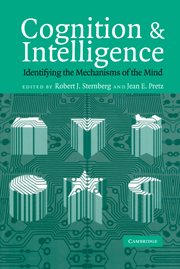Book contents
- Frontmatter
- Contents
- Preface
- 1 Information Processing and Intelligence: Where We Are and Where We Are Going
- 2 Mental Chronometry and the Unification of Differential Psychology
- 3 Reductionism versus Charting: Ways of Examining the Role of Lower-Order Cognitive Processes in Intelligence
- 4 Basic Information Processing and the Psychophysiology of Intelligence
- 5 The Neural Bases of Intelligence: A Perspective Based on Functional Neuroimaging
- 6 The Role of Working Memory in Higher-Level Cognition: Domain-Specific versus Domain-General Perspectives
- 7 Higher-Order Cognition and Intelligence
- 8 Ability Determinants of Individual Differences in Skilled Performance
- 9 Complex Problem Solving and Intelligence: Empirical Relation and Causal Direction
- 10 Intelligence as Smart Heuristics
- 11 The Role of Transferable Knowledge in Intelligence
- 12 Reasoning Abilities
- 13 Measuring Human Intelligence with Artificial Intelligence: Adaptive Item Generation
- 14 Marrying Intelligence and Cognition: A Developmental View
- 15 From Description to Explanation in Cognitive Aging
- 16 Unifying the Field: Cognition and Intelligence
- Author Index
- Subject Index
- References
7 - Higher-Order Cognition and Intelligence
Published online by Cambridge University Press: 23 November 2009
- Frontmatter
- Contents
- Preface
- 1 Information Processing and Intelligence: Where We Are and Where We Are Going
- 2 Mental Chronometry and the Unification of Differential Psychology
- 3 Reductionism versus Charting: Ways of Examining the Role of Lower-Order Cognitive Processes in Intelligence
- 4 Basic Information Processing and the Psychophysiology of Intelligence
- 5 The Neural Bases of Intelligence: A Perspective Based on Functional Neuroimaging
- 6 The Role of Working Memory in Higher-Level Cognition: Domain-Specific versus Domain-General Perspectives
- 7 Higher-Order Cognition and Intelligence
- 8 Ability Determinants of Individual Differences in Skilled Performance
- 9 Complex Problem Solving and Intelligence: Empirical Relation and Causal Direction
- 10 Intelligence as Smart Heuristics
- 11 The Role of Transferable Knowledge in Intelligence
- 12 Reasoning Abilities
- 13 Measuring Human Intelligence with Artificial Intelligence: Adaptive Item Generation
- 14 Marrying Intelligence and Cognition: A Developmental View
- 15 From Description to Explanation in Cognitive Aging
- 16 Unifying the Field: Cognition and Intelligence
- Author Index
- Subject Index
- References
Summary
INTRODUCTION
We define higher-order cognition as information processing phenomena in which the metacognitive factors of monitoring and control play the fundamental role. This term is practically synonymous with complex cognition, because compound problems rely on the processes of monitoring and control to much greater extent than simple problems do. In this chapter, we review the literature on the relationships between human intelligence and complex, higher-order information processing. First, we will discuss the criteria of complexity of cognitive tasks. Then, we will provide a selection of empirical data concerning intelligence and problem solving. A section will be devoted to the studies that directly address the problem of the role of metacognition in intelligence. The chapter ends with the discussion of basic methodological problems involved in the study of relationships between higher-order cognition and intelligence.
INTELLIGENCE AND COGNITIVE COMPLEXITY
Intelligence is frequently defined as the ability to solve complex problems (Sternberg & Detterman, 1986). According to Carlstedt, Gustafsson, & Ullstadius (2000), who commented on the results of the survey conducted by Linda Gottfredson (1997), two aspects of human intelligence appear essential: quick adaptation to new situations and efficient solution of complex cognitive tasks. Hence, to determine who is intelligent we need to work out the criteria based on either novelty or complexity. In practice, the complexity criterion is more frequently applied, at least in measurement, because novel tasks and situations are hard to arrange in controlled conditions of psychological assessment.
- Type
- Chapter
- Information
- Cognition and IntelligenceIdentifying the Mechanisms of the Mind, pp. 122 - 141Publisher: Cambridge University PressPrint publication year: 2004
References
- 4
- Cited by



